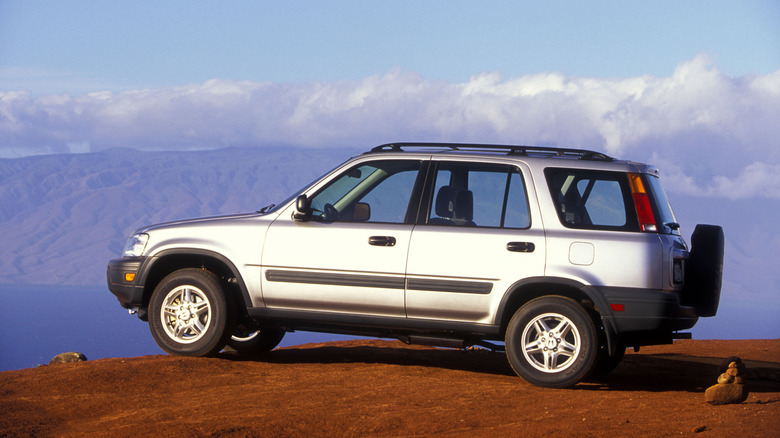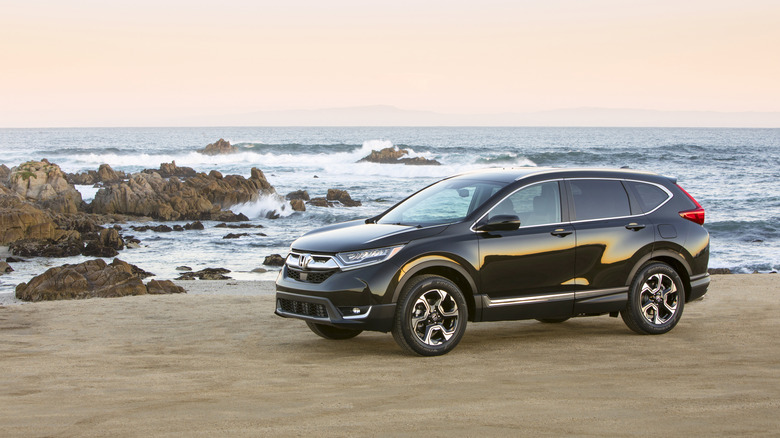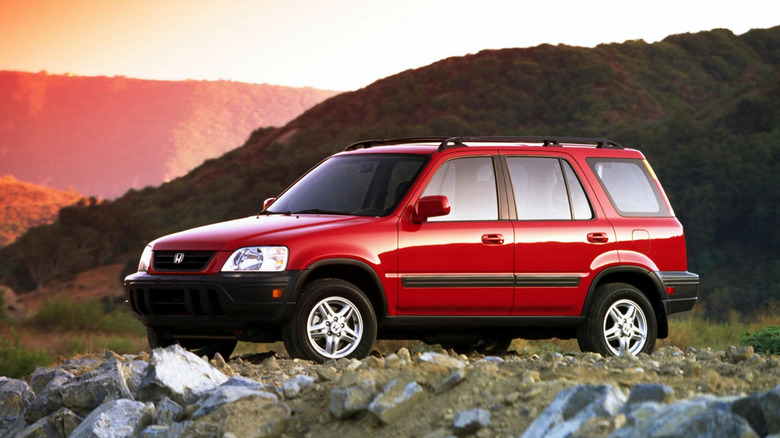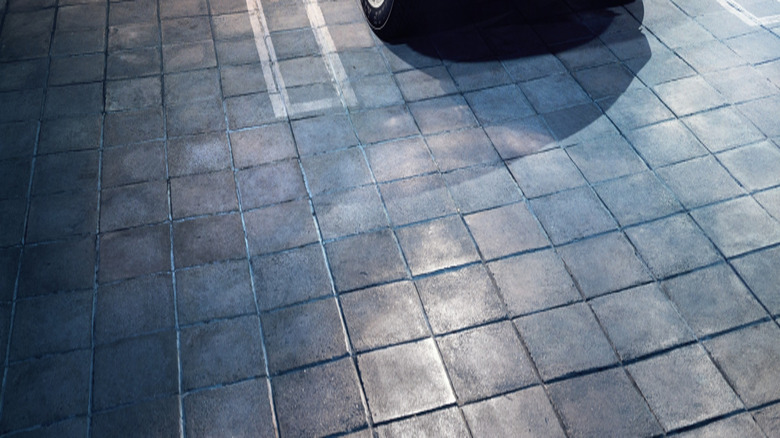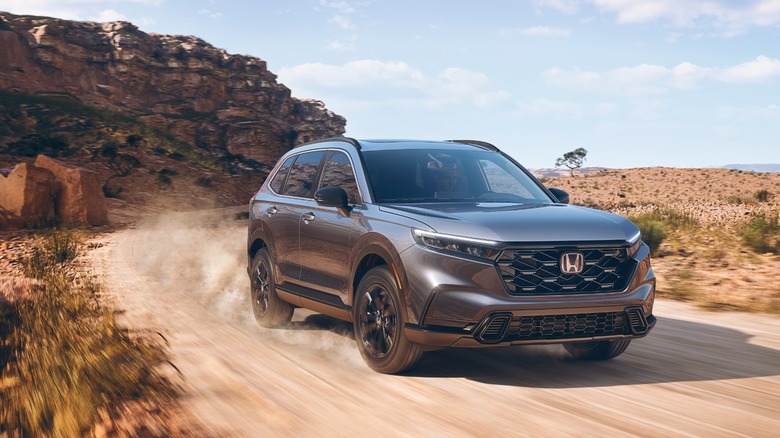Every Generation Of Honda CR-V Ranked Worst To Best
Six generations in, and the Honda CR-V has transformed from a scrappy lifted hatchback to the official vehicle of suburban households everywhere. But that doesn't necessarily mean it improved year to year. Some CR-Vs will run forever on nothing but regular oil changes. Others will have you Googling "lemon law attorney" at 2 a.m. while sobbing into your warranty paperwork. Let's just say the improvements definitely weren't linear.
But how are you supposed to separate the rock-solid daily drivers from the cash-guzzling messes? Don't worry. You don't have to go it alone. We're here to help you avoid heartbreak (and the repair bills) the next time you go to buy a Honda CR-V. "How," you might ask? By ranking every generation from the very worst to the absolute best. To do that, we scoured owner reviews. Then, we checked reliability data. We even scanned enough service bulletins to make a seasoned mechanic wince. Ready to see the results? Here's what you need to know.
6. Fifth generation (2017 to 2022)
The fifth-generation Honda CR-V? On paper, it was everything drivers wanted. It's super roomy, refined, and remarkably fuel-efficient for a compact SUV. But behind its smooth, quiet ride lurked an engineering blunder: the now-infamous 1.5-liter turbo oil-dilution fiasco. It all started with its revolutionary turbocharged engine, which rapidly turned into a chemistry experiment gone wrong. And why did that happen? The direct-injection system likely ran too cool to properly burn off excess fuel, causing unburned gasoline to drip down the cylinder walls.
The result? Fuel mixed with the oil. The oil stopped acting like oil. And engines began running rough, stalling, and in some cases, calling it quits entirely. A software update helped some vehicles, but many never fully recovered. By 2022, frustrated owners began trading in their nearly new CR-Vs for anything that didn't reek of gasoline fumes, and yep, a class-action lawsuit quickly followed. To its credit, the fifth-gen CR-V still gets the three must-have basics right: comfort, cargo space, and efficiency. But if you're shopping used, you need to be wary. So, ask for the service records, check to see if the update was done, and perform a little sniff test to make sure the oil doesn't smell like regret and gasoline.
5. Third generation (2007 to 2011)
Ah, the third generation ... This is where the CR-V finally ditched its dorky spare tire backpack in an effort to get a bit more stylish. It got rounder and more upscale, and the press absolutely ate it up. U.S. News called the 2007 model an award-winner with "space and storage capabilities galore." And they were right. It has fantastic cargo space, a decent ride, and the ever-popular K-Series engine. So, why is it only number five? Because this generation is super needy.
Its most famous problem is the A/C compressor spontaneously failing. This issue was so widespread that Honda finally extended the warranty on the A/C clutch, confessing it wears out, rattles, and stops doing its only job: blowing icy cold air. It's really not a matter of if your A/C will die, but when, and you can bet it will be on the hottest day of the year. The car you're eyeing has a new A/C clutch? Don't celebrate just yet. The rear differential on these CR-Vs binds and groans in tight turns when the diff fluid's been ignored. A simple fluid swap might fix it, but both of these problems are likely to be costly. And remember, these are all old enough to have tired shocks and bushings, so plan on a suspension overhaul unless the seller's receipts say otherwise.
4. First generation (1997 to 2001)
Before crossover was even a buzzword, Honda lifted its beloved Civic, tossed in a picnic table, and boom, the first-generation CR-V was born. And its unpretentious, practical charm forged a die-hard fanbase pretty much overnight. Why do people love it? Because it's from an era when Honda was really Honda. The 2.0L B-Series engine is seriously bulletproof. Don't believe it? Edmunds owner reviews are full of people bragging about hitting over 260,000 miles with minimal repairs. Beyond that, the "Man Maximum, Mechanism Minimum" design was in full effect. It had a flat floor, a walk-through cabin, and, of course, the legendary removable folding picnic table that doubled as the cargo floor. Genius.
But don't let '90s nostalgia cloud your judgment. With just 126 horsepower, it's not exactly fast. The interior is a noisy sea of '90s gray plastic. And while the crash safety was acceptable for 2001, it's outdated by modern standards. The Insurance Institute for Highway Safety (IIHS) gave the 2001 model a "Marginal" rating on its frontal crash test. How marginal? The test dummy's head bottomed out the airbag and hit the steering wheel, then rebounded to smack the B-pillar. Ouch. So yeah, maybe don't crash it. But if you want a cheap, reliable little SUV, the first CR-V still holds up; just watch out for rust and a dodgy service history (as is the case with all old cars).
3. Fourth generation (2012 to 2016)
The fourth-generation CR-V is the car that defines the word "fine." It's Honda's calm before the storm of the fifth-gen's turbo-disaster, but let's not confuse calm with great. The fact is that it's aggressively, unapologetically middling. It's reliable enough, comfortable enough, and quick enough to keep you from complaining. Its saving grace is the 2.4-liter K24, Honda's last naturally aspirated hurrah before the turbo era. K-Series engines are a tuner favorite for their endless potential. But stuffed into a 3,500-pound CR-V? Well, let's just say it's no track day hero.
If only being boring was its only crime. But the fourth-gen CR-V came with a whole subscription to minor annoyances. The cabin? A full symphony of road noise. The tech? Already outdated the day it rolled off the line. And that glorious K-Series? A few quirks take some shine off its halo. Most notably, the 2012 to 2014 models loved to do the transmission judder, making you feel like you were driving over rumble strips. The 2015 model avoided that mess, but it had its own issue: intermittent engine vibration. And, on top of that, it's the generation that betrayed us all by axing the picnic table. So, yeah, it's fine. Just fine.
2. Sixth generation (2023 to present)
Is the sixth-generation CR-V a winner? No question. It's the most grown-up CR-V ever built — quiet on the highway, comfy in traffic, and proof Honda's been perfecting the formula for decades. The ride quality is fantastic, the Body Stabilizing Seats are genuinely comfy, and the interior is massive, boasting the most cargo room in CR-V history (a whopping 76.5 cu-ft). The tech is finally modern, and the 204-hp hybrid system is punchy. And that's its only problem. It's just so ... pedestrian.
The sixth-gen CR-V will never surprise you, never excite you, and never let you down. It's the trusty car you buy for commuting, not the car you lust after. That said, it's not immune to the usual first-year hiccups that come with any redesign, such as vibrating mirrors, detaching roof drip molds, and electronic gremlins. These are all pretty minor issues, though, not (thankfully) fifth-gen-style engine meltdowns. But it shows that even near-perfection can be a bit of a snooze. Apparently, Honda's own team agreed. The only way to make the new CR-V truly exciting was to bolt in an 800-hp IndyCar motor and call the result The HPD Beast. Did it catch the attention of car enthusiasts? Oh, yes. But for everyone else, the basic sixth-gen is an excellent everyday appliance.
1. Second generation (2002 to 2006)
So which CR-V is the G.O.A.T.? The first gen kicked things off with its quirky charm, but the second-generation CR-V perfected the formula by adding the legendary K24 powerplant. At just over 3,200 pounds, it was the lightest CR-V ever to rock a K-series, and that 160-horsepower i-VTEC engine made it surprisingly eager. Car and Driver timed the five-speed manual at 8.4 seconds to 60 MPH, noting its ability to "lunge and squirt its way into holes in traffic" in lower gears. Marvelous.
It was a lean, quick-witted little ute with a bulletproof, timing-chain-driven heart. No turbo or CVT, just pure, unadulterated Honda reliability. Oh, and don't forget ... THE PICNIC TABLE. Not only did it come standard, but it was bigger than the first gen's. It even covered a secret waterproof bucket for your muddy hiking boots. It doesn't get much more awesome than that. Of course, even legends have their weak spots. The second-gen CR-V earned a nasty reputation for the so-called A/C Black Death, where compressors on early models liked to spray metal shrapnel through the whole system. Expensive to fix? Oh, you bet. And after two decades on the road, rust and neglect are a given. But hey, once your CR-V falls apart, you can always pull its K24 and give your golden era Honda the power it deserves.
Sorting the legends from the headaches
When ranking Honda CR-V generations, it's less about spreadsheets and more about answering the question: "Which CR-V would you actually want sitting in your driveway every morning?" The methodology looks at whether the engine will grenade itself, whether owners are forming fan clubs or filing lawsuits, and whether you'll need a second mortgage for repairs.
Basically, we looked at all the stuff that matters when you're stuck in traffic on a Tuesday, thinking about all of your life choices. We did that with help from long-term reliability data, owner-reported problems, and real-world buyers' guides. To separate internet rumors from confirmed recurring issues, we also checked Honda service communications and TSBs.
